FIFA World Cup: How the high-tech ball for the FIFA World Cup 2022 can change football
The FIFA World Cup 2022 ball, like balls from previous editions of the tournament, does not only have unique distinctions but also a unique name.
 First Time: 2022 World Cup will use tracking technology inside the ball to help make important calls
First Time: 2022 World Cup will use tracking technology inside the ball to help make important callsThe ball, called Al Rihla, which translates to ‘the journey’ in Arabic, has a distinctive look, but it will be remembered for something more important than its looks.
The ball uses a sensor that collects spatial positioning data in real-time. The first obvious benefit of this system is that it will make decisions like offside far more streamlined.
That addresses a central sticking point among fans of the current Video Assistant Referee (VAR) set up – the speed at which offside decisions are made.
Currently, the World Cup system is semi-automated - most of it will be driven by AI, but there will also be a human element.
How exactly does it work? Well, the sensor in place picks up any touch made on the ball – whether it be a header, kick, pass, or anything else – at a rate of 500 frames per second.
This is combined with optical camera tracking with HawkEye, a system best known for its work in tennis which has also been used for ball tracking in cricket.
This dream team of a sensor and HawkEye allows for offside decisions to be made much quicker and will reduce the number of stoppages caused for an offside call.
The amount of research that has gone into this has been massive. The technology went through about six years of testing before FIFA went ahead and approved it for this year’s World Cup.
Plus, the current technology isn’t the final product – improvements will be made based on real-time feedback that will arrive as and when the tournament goes on.
However, this is such a game-changer because such data can be used for more than just officiating purposes.
It can also change how the game is viewed by giving broadcasters new ways to educate, inform and dissect football matches for fans.
Furthermore, it can bring about changes in new camera angles or give fans the ability to view new perspectives while watching the match.
In addition, the kind of data that can be collected from the ball will also impact how players and teams prepare for games going forward.
Football is already at a point where a data-driven approach is key to success at any game level.
Having more data to use as a team will only make teams work harder to find more areas to make gains and reduce the margins between them and superior oponents.
While the FIFA World Cup 2022 remains, at least until this point, the tournament of controversies, there is every chance it could have a positive legacy as well – at least in terms of further intertwining the worlds of technology and football.
Editor's Picks
- 01
Brendon McCullum: England ready to be 'really brave' in team selection for India series
- 02
Diogo Jota inspires Liverpool surge as injuries fail to dampen Premier League lead
- 03
Cameron Norrie ready to go toe-to-toe with the big boys after stellar Australian Open run
- 04
Maxwel Cornet confident of scoring run after opening West Ham account